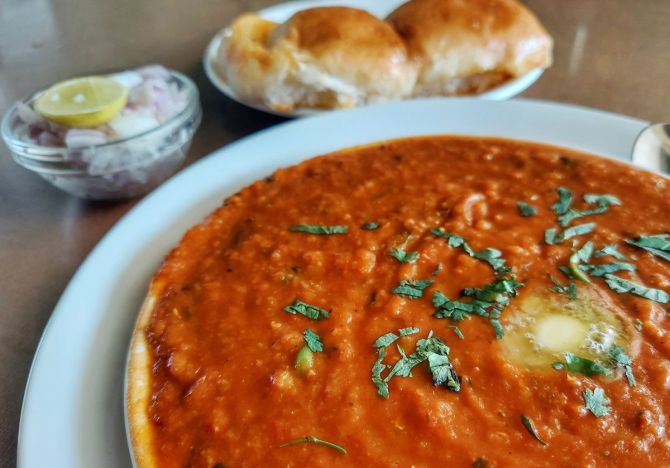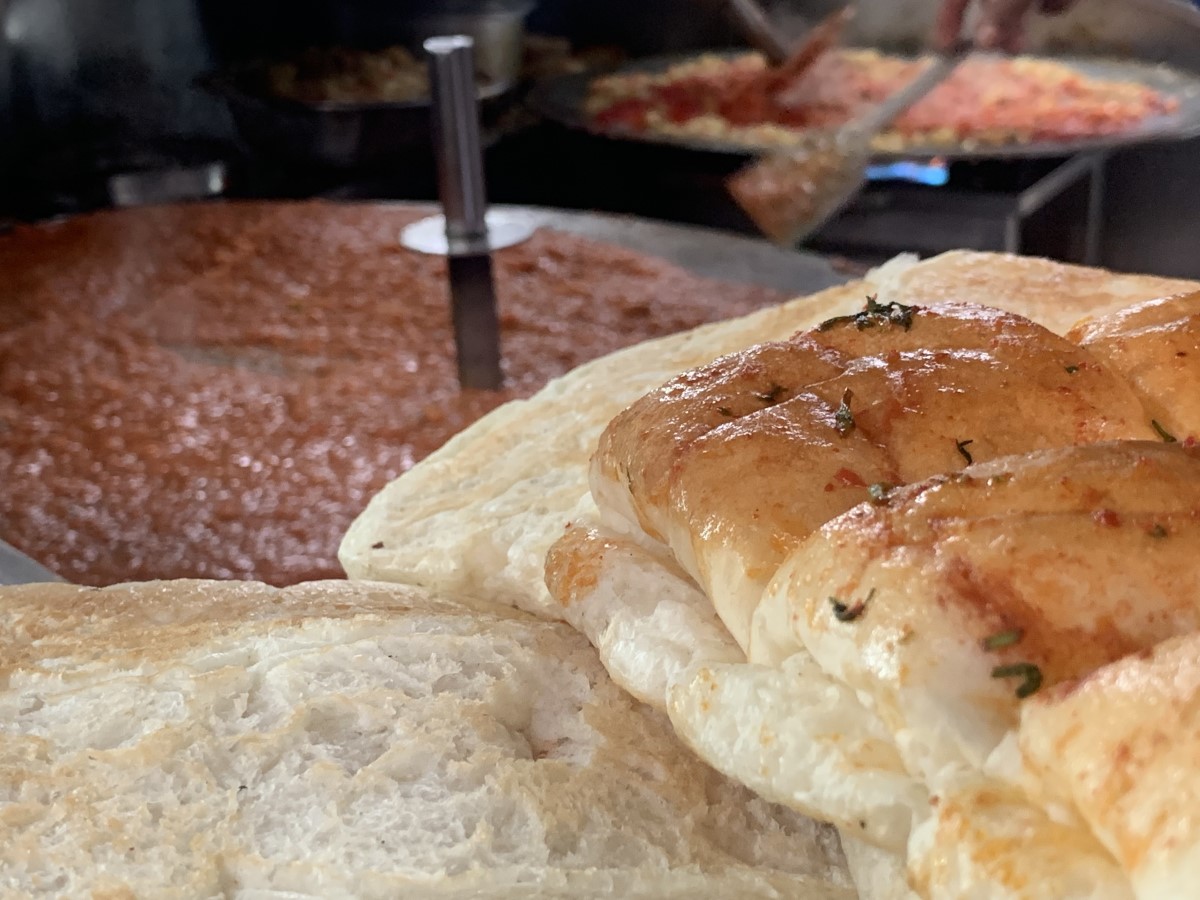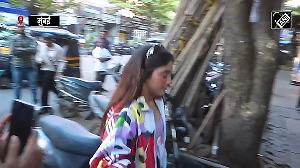When you make the Bombay all-time favourite Pav Bhaji at home, it tastes quite different from the Pav Bhaji you might eat at your specially chosen street food vendor.
But buttery fresh-off-the-stove bhaji tastes very good too -- it's bit like how dosas made at home are just as good as a paper dosa had at a restaurant.
While making home bhaji you can also moderate the spice and the butter.
The best-tasting Pav Bhaji -- pan-fried soft rolls crispened up and served with cooked spiced mashed vegetables -- has, of course, a lot of butter.
If you would like to cut back on the butter, reserve it for frying the pav, where the taste is kinda essential.

Many types of vegetables go into Pav Bhaji. In this recipe I have added the vegetables my family prefers to eat in their bhaji. But carrots, cabbage, beans, a red capsicum, even mushrooms, may be added too for taste and additional nutrition as well.
Finding the right substitute for a pav or poiee outside of Mumbai or Goa might be a challenge. You could try a dinner roll or a Scottish bap-kind of bun or a pocket-sized ciabatta.
The reason why Pav Bhaji is a very Mumbai dish harks back to the introduction of pao to Mumbai from Portugal when Bombay was under the Portuguese crown. Also, according to information from various sources, its Mumbai popularity happened because the city's army of mill workers once apparently often lunched on the cheap, filling Pav Bhaji.
If you have brought Lord Ganesha home this season and are expecting family and friends to drop by, serve up as a one-plate meal, with the modaks, some hearty Pav Bhaji by Zelda Pande.

Pav Bhaji
Serves: 4
Ingredients
- 3 large potatoes, peeled and cut into large pieces
- Handful or 2 frozen peas, which mashes better than fresh peas
- 3 tomatoes roughly chopped + 1 chopped fine
- 125 gm cauliflower, roughly chopped
- 1 tbsp oil + 1 tsp oil for pressure cooking the vegetables
- 2 tej patta or bay leaves
- ½ green capsicum, cored, deseeded, finely chopped
- 2 medium onions, finely chopped
- 5 pods garlic, roughly crushed
- 1-inch piece ginger, grated
- ½ tsp hing or asafoetida
- ½ tsp jeera or cumin seeds
- 2 tbsp butter + 1 tbsp for the tempering
- Salt to taste
- 2 tbsp Everest Pav Bhaji masala
- 2 tsp lal mirchi or red chilly powder
- 2 green chillies, finely chopped, optional
- Water
For serving
- 10-12 pavs
- Butter to fry the pavs
- 2 large onions, chopped, for serving
- 2 limes, chopped into quarters, for serving
- 4 tbsp chopped green dhania or coriander or cilantro, for garnish
- Butter for serving
Method
- In a pressure cooker boil, for 8 seetis or whistles, over medium heat, the potatoes, tomatoes, peas, cauliflower with enough water to cover the vegetables and add a little oil, tej patta.
Take off heat.
Open up the cooker.
Allow it to cool a bit and mash well when still warm. - In a deep heavy-bottomed saucepan or kadhai, saute, over medium heat, 1 tbsp oil and add 1 tbsp butter, jeera, hing, chopped onions, green chillies and the mashed garlic for 4-5 minutes.
Add the chopped green capsicum and the grated ginger and saute for 1-2 minutes more.
Add the mashed vegetables and a little water, about frac34; cup.
Add the 2 tbsp butter, salt, Everest Pav Bhaji masala, lal mirchi powder and the remaining chopped tomato.
Cook and mash at the same time for about 10-15 minutes.
Add water, if required, so the consistency is thicker than a heavy vegetable stew (more like the consistency of a wettish khichdi) and bring back to a simmer.
Take off heat. - After the bhaji is ready and hot, fry the pavs on a tava or griddle by splitting open two pavs together, buttering both sides.
Flatten a little with a spatula as you fry and flip over till both sides turn a little pink. - Serve the Pav Bhaji garnished with green dhania on a plate or thali with the pav, and the chopped onions and quartered limes on the side.
You may like to add a dot of butter on top of the bhaji while serving.
Zelda's Note: For Jain Pav Bhaji use 3 peeled green bananas, cut into large chunks, instead of potatoes. Skip the onions, ginger and garlic, add 1 tsp saunth or dried ginger and up the hing.
If vegan, use cashew butter instead of dairy butter.
To lower the calories and carbs, use green bananas instead of potatoes and cut back on the butter. Instead of pav use whole or multigrain buns.
For low-sodium Pav Bhaji use unsalted butter and bake your own rolls. Most bread or rolls or pav may have a higher sodium content. Opt to make your own pav or rolls from scratch using Georgina Umdor's Bread Roll/Pav (external link) recipe: Mix 450 gm maida or all-purpose flour, 7 gm instant yeast, 1 tbsp vegetable oil, 350 ml lukewarm water and knead for 5-7 minutes into a smooth dough.
Cover and allow it to rise for an hour.
Knead again till smooth and divide into 8 round pieces.
Place, spaced out, on a baking sheet to rise for a further 30 minutes. Brush with a little beaten egg and bake in a preheated oven at 220 ° C for 10-15 minutes or till golden brown.
You may want to add a 2 tsp kasuri methi or dried fenugreek and 1 tsp crumbled dagar phool or stone flower to the bhaji while it is cooking, for a new taste.
Grate a little cheese onto the bhaji while serving for a richer flavour.
I prefer using Everest Pav Bhaji masala because the taste is more subtle and the masala flavour none too harsh. Pav Bhaji masala is available in most grocery stores/Indian grocery stores in India and abroad.
You may make your own Pav Bhaji masala by dry roasting 3-4 Kashmiri de-stemmed chillies, 10 gm jeera, ½ tbsp sonf or fennel seeds, 3-4 laung or cloves, a few black peppercorns, 1-2 tbsp coriander seeds, 1-inch piece cinnamon, 1 black elaichi or cardamom and then add 1 tsp aamchoor or dried mango powder and a dash of black salt.
Grind in a blender or a spice mill to a fine powder and store the excess in a labelled zip-lock bag in the freezer, where it will stay fresh for a year plus.











